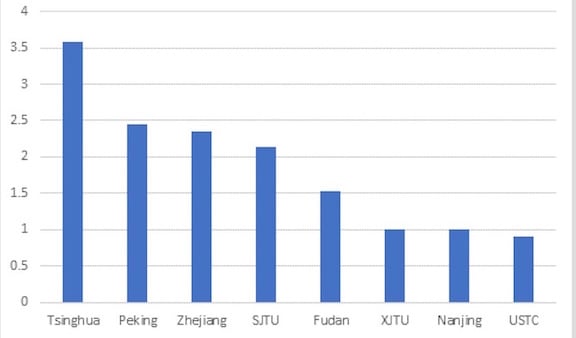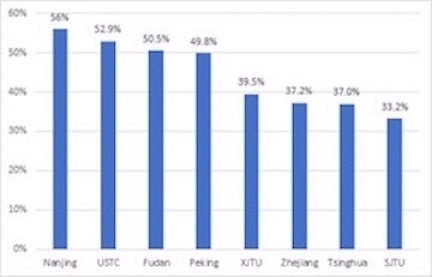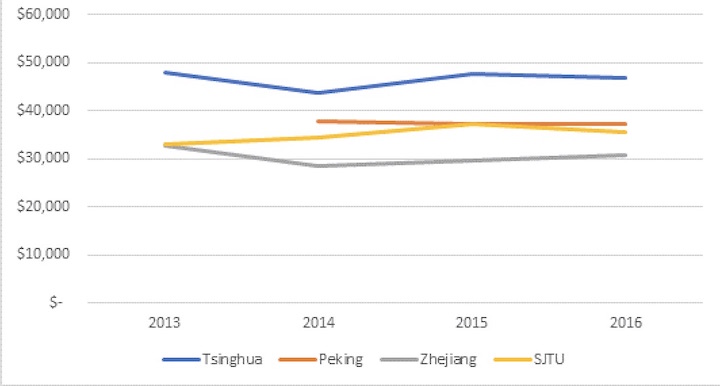You have /5 articles left.
Sign up for a free account or log in.
One of the difficulties in trying to draw international comparisons in higher education is the differing levels of government and institutional transparency about financial support. In North America, institutional transparency is complemented by decent national-level statistics about how institutions spend their money through the Integrated Postsecondary Education Data Set in the US and the Financial Information for Universities and Colleges dataset in Canada. But elsewhere, data can be harder to find. Universities in most big OECD countries will at usually post financial statements and if not, at least some very basic statistics about income and expenditure. French universities, that publish essentially no financial data at all are the big exception here. But in the Middle East and much of Asia one this data is simply absent.
It is of some interest that in 2012 the Chinese government published a “transparency directive” for the higher education sector. Much of it had to do with ensuring that institutions published information on their policies and especially, the gaokao scores required for admission for students, but included in the directive was a demand that institutions publish some type of annual financial report. Compliance has not been 100%, and the data does not contain a high level of detail but nevertheless, we have five full years of such information (2012-2016) for most of the major institutions. And this new data tells three rather important stories.
The first is that top Chinese universities are really quite wealthy, and comparable in financial muscle to some top US institutions. The largest institution, Tsinghua University, had annual expenditures of RMB 13.7 billion in 2016, which translates to about US$3.57B at purchasing power parity, making it larger in raw terms than both MIT ($3.34 billion in 2014) and Yale ($3.36 billion). The next largest institution, Peking University, had 2016 expenditures of roughly $2.45 billion, which puts it roughly in the same category as CalTech and Washington University in St. Louis. Zhejiang University and Shanghai Jiao Tong University, the two next biggest, have expenditures of $2.3 billion and $2.1 billion, respectively. Fudan, in fifth place, has expenditures equal to US$1.5 billion, which is roughly equivalent to Princeton.
Expenditures, in Billions of $USD at PPP, Top Chinese Universities 2016

Now it should go without saying that these Chinese universities are substantially larger than the American private institutions to which they have been compared above. But the numbers for the Chinese universities are still large: just under $47,000 per student at Tsinghua, $37,000 at Peking, $35,000 at Shanghai JiaoTong and $31,000 at Zhejiang and Fudan. That’s a long way off MIT and Harvard, and even behind major US public institutions like Berkeley and Michigan, but it still rates competitively with, for instance, major Canadian universities like Toronto, British Columbia and McGill.
The second story in the data is that top Chinese institutions look more like North American ones than one might expect in terms of their income sources. At four of the top institutions – Shanghai Jiao Tong, Xian Jiao Tong, Tsinghua and Zhejiang – income from public sources accounts for less than 40% of the total budget. A small part of the remainder comes from tuition fees, but the majority is outside income, including from business interests like Tsunghua’s massive University Enterprise Group. This is not unlike American institutions that frequently have massive income streams from things like hospitals, property, etc. Other Chinese institutions have higher degrees of public financing, but none of the major “C9” group of universities (sometimes called China’s Ivy League) receive more than 60% of their funding from public sources.
Percentage of Expenditures Received From Government Sources, Top Chinese Universities 2016

We have already seen that at the very top end at least, Chinese universities are at least competitive with major US institutions as far as finances go. But one consistent narrative—pushed among others by big international rankings outfits—is that Chinese universities are closing the gap with universities in developed countries, that suggests that Chinese university expenditures are rising quickly.
The phenomenon of rising institutional expenditures in China may have been a factor last decade, but it does not appear to be the case for the years for which data is now available. Adjusted for inflation and growth in student numbers, it turns out that expenditures at top Chinese universities have stayed more or less stable over the period 2012-2016 with some universities rising and others falling, but all in a band of about 5%.
Expenditures Per Student in $USD at PPP, Top Chinese Universities, 2013-2016

In short, the glimpse into the finances of top Chinese universities suggests they share more than we might have imagined with US flagship public universities, but also that claims of imminent “catch up” might be overblown.

